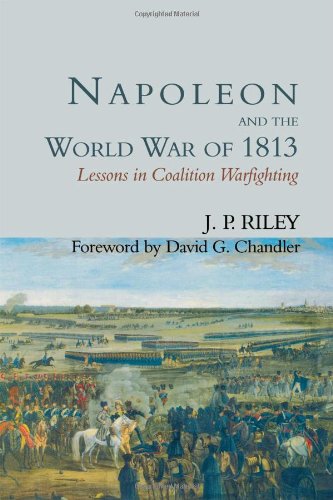It’s been a while since I have posted anything. I’ve been reasonably busy on the hobby front, but I’m getting a bit bogged down on improving my terrain – which involves many parallel paths with a rather distant endpoint. Meanwhile I have been reading a bit, and I’m reporting back on this book by Lieutenant-General Jonathan Riley (or J.P. Riley) published back in 2000. I remember reading a review of it in The Economist, and I eventually picked it up at a bookstall in Salute a number of years later; it languished a number more years before I eventually read it. Since my Napoleonic hobby projects are increasingly focusing on 1813, after 1815, it struck me as relevant.
The book is a high level account of three campaigns in 1813: in Central Europe, with the decisive battle of Leipzig, in Spain (with Vitoria as the centrepiece) and in North America, especially in Canada as the War of 1812 played out. The nominal theme of the book is the study of how multinational coalitions work in warfare, where he draws out parallels from later wars, right up to NATO. The coalitions are self-explanatory in the case of the first two campaigns (and include Napoleon’s armies in Central Europe, albeit that the French allies were highly subordinate); in Canada the British side is presented as a coalition between the British government, French and British colonists, and the Native American tribes (which he, back n 2000, is able to call “Indians”, though his account does accord them full respect). The narrative and the commentary on coalitions don’t integrate entirely satisfactorily though – the narrative tends to take over, and it is not especially penetrating on his main subject. I read a very interesting study of coalition fighting a few years ago which was based on a research thesis by an American military academic, which used the Russian-Prussian alliance in 1813 as a case study – and which got much more into the weeds of coalition warfare. It was able to do this because the researcher got behind the mainstream campaign accounts and into some of the telling details. An example was the complaint that Russian generals were a bit too free and easy with exposing their troops to artillery bombardment, according to their Prussian subordinates.
General Riley does hit on some important insights, though, showing features of coalition warfare which military historians tend to present as command failures. It is the nature of coalition warfare that campaigns only continue for as long as common objectives remain agreed. For example as the allied armies reached the Rhine at the end of the year they stopped; some commentators (starting with, at the time, Jomini) regretted this as a wasted opportunity, as Napoleon was vulnerable. But the allies had never agreed to enter France as a coalition, as some members (notably Austria) had reservations about what might happen next – they liked the idea of a reasonably strong France, and were not signed up to a restoration of the Bourbons. The coalition simply had to stop to consider their next move, and see if Napoleon would come to terms. This in turn delayed Wellington’s invasion of France. This is not unlike the first Gulf War after Kuwait was recaptured more easily than many thought. The coalition could not simply proceed to Baghdad.
I was a bit disappointed with the campaign narratives for Central Europe and the Peninsula. The book was never meant to deliver anything special here, but it is very British Old School, based on secondary sources in turn derived primarily from British and French sources. Doubtless this was under the influence of the great historian David Chandler, who contributed the forward. His work was largely where I started my serious history reading back in the 1970s, but we’ve moved on. The Central Europe account is very much centred on Napoleon, with the deliberations of the allies treated very superficially – a big weakness for a book on coalition warfare. I am still none the wiser as to why the allies did not withdraw after the first day of Dresden, for example. And he keeps to the generally accepted story that Napoleon nearly beat the Army of Bohemia on the first day of Leipzig, with the day being saved by the intervention of Tsar Alexander. I simply don’t think that Napoleon had enough hours in the day to accomplish what he needed to do to win the battle, and this story has evolved from the typical French historian’s downplaying all Napoleon’s failures. The allied armies of 1813 were very resilient, had plenty of cavalry, and were very hard to beat properly. But I don’t know enough about the events of this day to present a convincing case – or any opinion on the Tsar’s intervention. The focus on Napoleon and the French also brings forward the lack of initiative shown my most of his senior commanders – and this is discussed as a downside of his highly centralised system of command and control. This is fair enough, but the obverse is not commented on. This is that the allied subordinate commanders often showed good judgement and initiative – something that had not been noted earlier in the wars.
I had similar problems with the account of the Peninsular campaign. Here the problem is the tendency to shoehorn the account onto a very standard British stereotype, of the French coming on “in the same old way” at steadfast British infantry, and increasingly steadfast Portuguese and Spanish, with every encounter being on a ridge. I have only researched Vitoria properly, where General Riley does underplay the French tactical successes, without being seriously wrong on the overall narrative. For Sorauren I noted that he did not follow Oman’s somewhat more nuanced narrative, and went for a very old-school version that this was a typical encounter – though I don’t think the overall distortion matters all that much in the end.
General Riley’s account of the War of 1812 was much more interesting, as this was something I knew little about. The actual campaigns are not all that interesting in themselves – though doubtless a good source of small scale encounters of the sort that make interesting wargames without all the difficulties large scale battles bring. The interesting bit was the differing interests of the various groups, from American settlers to Canadians to native Americans. I hadn’t appreciated that one of the big issues that drove the original conflict between the colonies and home government in America was that the colonists wanted freedom to displace the Native Americans – which is why the latter sided with the British. It goes to show just how ethnically-centred the concept of freedom was that drove the American revolution.
Overall this a flawed book that hasn’t aged well; I wouldn’t recommend that anybody buy it. The subject matter is interesting, but we can surely do much better these days. Good military history demands confident coverage of the big stuff – the bigger context and politics – and a willingness to look hard at the small stuff. General Riley does the first part well enough, but is disappointing on the second.

